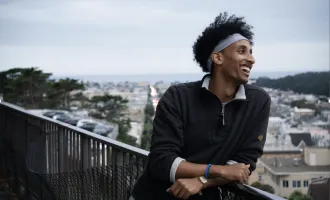Clinic Chronicles
Le Wen Chiu's "Clinic Chronicles" is the second place winner in the Synapse Storytelling Contest personal essay category.
“When does the Clinic open?” I hear amongst the bustle as I walk down the crowded aisles of beds at the Multi-Service Center South with my pen, notepad, and stethoscope.
I’m spotted easily, as this is a routine that has been familiar to the MSC-South since 1991. As I survey the shelter, I see scores of men and women sitting patiently with their scant belongings, waiting for a bed to sleep in for the night.
The MSC-South is San Francisco’s largest homeless shelter, located at 525 5th Street, and it is home to the UCSF Shelter Clinic, where teams of first and second-year UCSF medical students, nursing and nurse practitioner students, together with UCSF physicians or residents deliver urgent health care and referral services to shelter residents.
Having expanded services since its opening to include dermatology, ophthalmology, pharmacy, dental, women and men’s emotional support, and women’s health, the Clinic has also taken on the role of educating the next generation of future healthcare providers on the unique needs of people experiencing homelessness.
“It requires a unique skill set that we don’t get in training for the most part,” said Henry Carter, first-year UCSF medical student and co-director of the Clinic Leadership Board.
“People don’t perceive homeless patients as a unique community with certain medical needs and preferences, and this is a way of developing skills to treat this population in a way that is sensitive and supportive.”
Previously known as the Homeless Clinic, the Shelter Clinic recently underwent a name change in an effort to eliminate the stigma and assumptions often associated with the word “homeless.”
Carter said the Clinic Leadership Board believes the term prescribes an identity to someone in a negative way, when the problem is not in fact homeless people, rather homelessness itself.
According to the US Department of Housing and Urban Development, there are currently over 8,000 people living on the street or in shelters in the city of San Francisco, a 17% increase since 2017.
This rapid and increasing rate makes homelessness a disturbing yet relevant topic in healthcare.
“Homelessness is the manifestation of failing political and economic systems, and the cause of the problem is much greater than us, but it’s something that we have to deal with appropriately as medical providers,” Carter said.
Because the Shelter Clinic patient population faces many structural issues on top of their own health issues, volunteers have tried to mitigate the health disparity by providing resources for social services.
“This population faces so many disparities, and health is just one piece of it,” said Katie Machado, a first-year nurse practitioner student and co-director of the Clinic Leadership Board.
“In addition to the medical care we’re providing, we’re also addressing a respect disparity that these people experience on a daily basis. We’re giving them a space to be heard.”
After starting to volunteer at the Shelter Clinic in 2018, Heidi Dittrich and Christina Camp, both first-year Masters Entry Program in Nursing (MEPN) students, and now public health directors for the Clinic, noticed there was no system in place to address the social determinants of health.
As such, they leveraged their own past experiences to build a case-management system this year to improve the Clinic’s data collection methods and patient needs assessment, as well as its outdated referral system.
Dittrich said she was tired of giving impersonal referrals, and there was no guided discussion about why a patient should choose one primary care or mental health clinic over the other.
So, through word-of-mouth in the social work community and talking to many people currently experiencing homelessness, Dittrich and Camp built a new referral system for primary care and mental health, along with help from the Clinic Leadership Board.
Now, their system divides clinics by location and includes a social work “cheat sheet” that delineates resources specific clinics can provide and the best way to get there from the MSC-South.
“This whole effort is founded in this belief that everything should be based on the patients,” Dittrich said. “So, we wanted to build this new system that would allow patients to be in the driver’s seat of their own health, beyond just their medical needs.”
The Shelter Clinic is open every Tuesday and Thursday night at the MSC-South, unless preceptors or attending physicians are unavailable to attend.
This is why the Clinic is always looking to expand their preceptor pool. The opportunity is open to both UCSF and community physicians.
Dr. Daniel Wlodarczyk, a general internist, and Dr. William Shore, a family medicine physician, are UCSF faculty advisors for the Clinic, and have volunteered their time to precept there for almost 30 years.
Dr. Shore said that working at the Clinic has been a rewarding experience, both from a patient care and student mentorship perspective.
“The commitment of the students to work with this population and provide healthcare, as well as help patients navigate the healthcare system is commendable and inspiring,” Dr. Shore said.
“It is very encouraging to see that year after year, the students want to be part of the solution as they become advocates for underserved patients.”
As a first-year medical student, I was nervous to see my first patient at the clinic, who, as I later found out, was a veteran with a history of depression and paranoid schizophrenia.
As I awkwardly sat him down on the examination bed, one of the first things he said to me was, “Don’t worry, I won’t hurt you.”
I heard the pain and frustration in his voice, and was reminded of the injustices and stereotypes he must have endured as a person experiencing homelessness for years.
I quickly apologized for the misunderstanding and proceeded by asking, “How are you doing?”
I did not do so to take a patient history, but rather because I suspected no one had genuinely asked him that question in quite a while.
Instead of seeing him as a patient, I saw him as a person who had been struggling and just needed someone to talk to.
We spent the majority of his visit talking about his past and his experiences with discrimination.
“You’ve brightened up my day,” he said. “Keep doing what you’re doing, and you’ll go far.”



